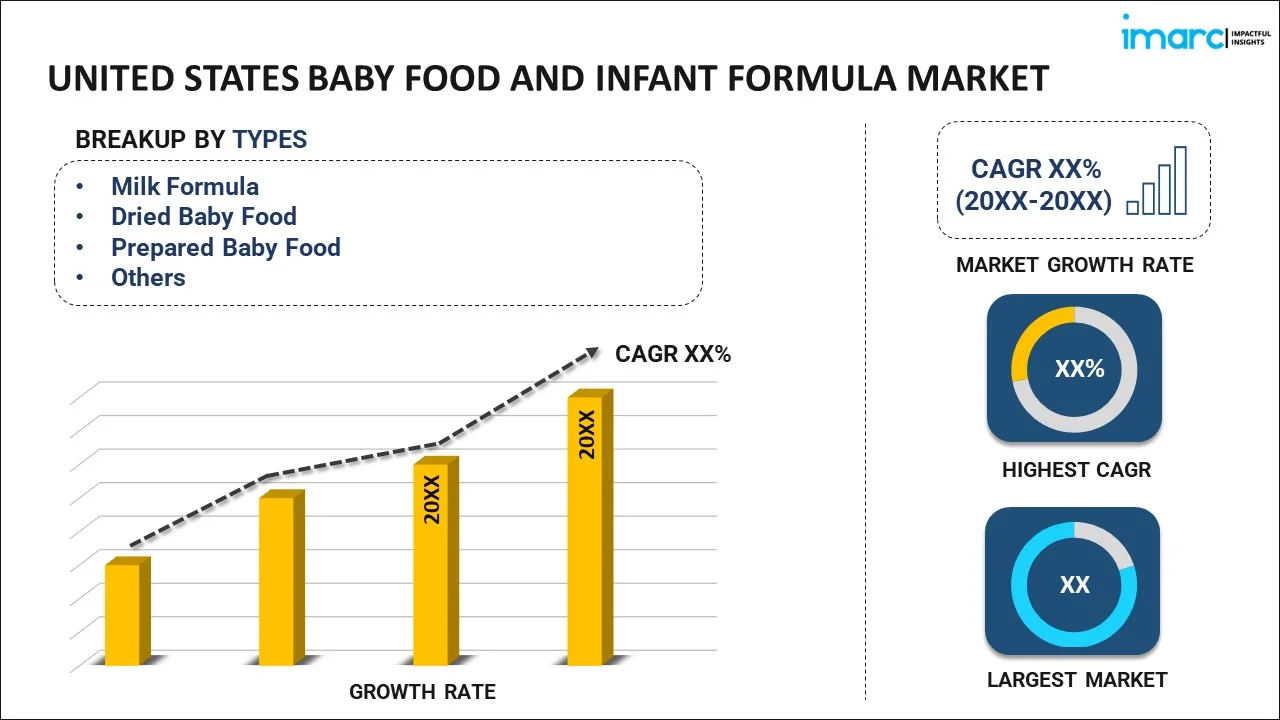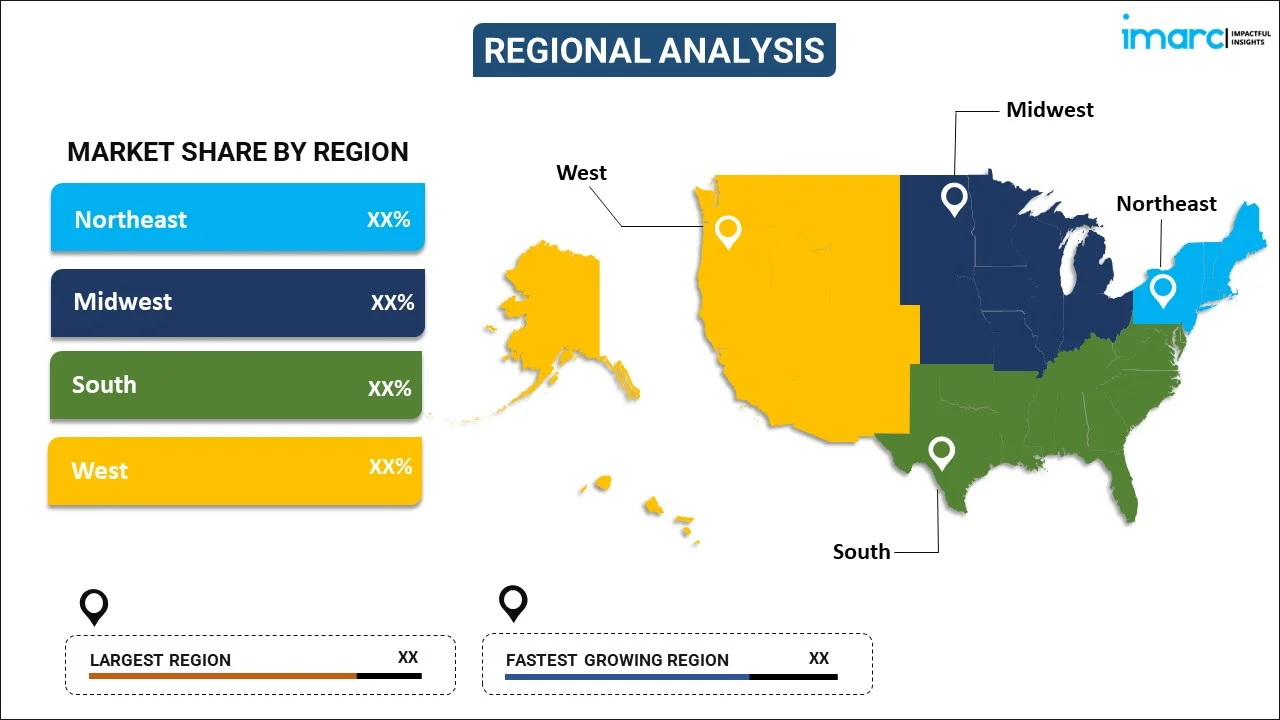
United States Baby Food and Infant Formula Market Report by Type (Milk Formula, Dried Baby Food, Prepared Baby Food, and Others), Distribution Channel (Supermarkets and Hypermarkets, Pharmacies, Convenience Stores, and Others), and Region 2025-2033
United States Baby Food and Infant Formula Market Size, Share & Analysis:
The United States baby food and infant formula market size reached USD 9.4 Billion in 2024. Looking forward, IMARC Group expects the market to reach USD 14.6 Billion by 2033, exhibiting a growth rate (CAGR) of 4.79% during 2025-2033. The market is fueled by growing parental concern for nutrition, rising demand for organic and functional foods, and growing e-commerce distribution. New developments like whole milk–based nutrition formulas and clean-label ingredients are redefining product innovation, while changing dietary tastes underpin long-term demand. Digital participation and tailored nutrition are also driving behavior within urban homes. Such a changing scenario indicates strong growth and diversification across every segment of United States baby food and infant formula market share.
|
Report Attribute
|
Key Statistics
|
|---|---|
|
Base Year
|
2024
|
|
Forecast Years
|
2025-2033
|
|
Historical Years
|
2019-2024
|
|
Market Size in 2024
|
USD 9.4 Billion |
|
Market Forecast in 2033
|
USD 14.6 Billion |
| Market Growth Rate 2025-2033 | 4.79% |
United States Baby Food and Infant Formula Market Insights:
- Key Market Drivers: Parenting that is focused on health, dual-income families, and greater awareness of early life nutrition are propelling demand for high-quality, convenient baby food and formula products that meet developmental requirements and streamline daily caregiving processes.
- Key Market Trends: More consumers are looking for organic, less-processed, and fortified options. At the same time, digital shopping behavior and interest in personalized nutrition are altering the way parents choose, access, and trust infant nutrition solutions.
- Competitive Landscape: The market features a combination of heritage and new brands with differentiated products in areas of nutrition, sustainability, and packaging. Brand preference and market positioning are driven by innovation, clear labeling, and direct consumer interaction.
- Challenges and Opportunities: Manufacturers are challenged by regulatory complexities and fluctuating raw material prices. Nevertheless, increasing demand for plant-based, allergen-free, and functional products provides substantial opportunities for brands to provide value through innovation and customized nutrition.
United States Baby Food and Infant Formula Market Trends:
Growth in Demand for Organic and Clean-Label Baby Food
Growing consciousness among parents regarding the health and well-being of infants has considerably impacted the demand for baby foods with organic and clean-label credentials in the United States. More caregivers now look for such products with open sourcing, less processing, and the absence of artificial additives, such as synthetic colors, preservatives, and genetically modified ingredients, in the baby food that they choose. This trend is part of a broader push toward natural, environmentally friendly consumption. Consequently, consumers have witnessed a mushrooming of organic cereals, vegetable and fruit purees, and minimally processed formulas with high quality standards. United States baby food and infant formula market trends suggest that traceability and sustainability are valued by consumers, and these attitudes are beginning to influence product formulation as well as labeling policies. The clean-label category is defined to continue growing as parents increasingly emphasize healthy choices that facilitate their infant's long-term growth, and it emerges as a signature space of innovation and demand in the industry.
The Growth of Functional and Fortified Formulas
Parents across the United States are increasingly looking for baby food and infant formula products that are geared up with functional ingredients enhancing early-stage cognitive, immune, and physical growth. As food technology develops, the market has grown to accommodate enrichments with nutrients like iron, calcium, DHA, ARA, and probiotics. Such enrichments nurture brain development, intestinal well-being, and general growth, complementing parental hopes to provide children with a solid developmental start. Products tailored to various infancy and toddlerhood stages are now being marketed with specific health advantage. United States infant formula and baby food market analysis demonstrates that this functional nutrition trend is fueled by demand for age-appropriate and evidence-based dietary solutions. As parents become more educated, they increasingly prefer products that are both convenient and powered by science-backed ingredients. This has created a well-segmented market addressing specialized nutritional requirements, affirming the role of fortification as a fundamental market driver.
E-Commerce and Direct-to-Consumer Channel Growth
The development of digital business has transformed the way United States parents consume baby food and infant formula, with e-commerce and direct-to-consumer (DTC) platforms seeing significant growth. Customers are attracted to the convenience of buying online, which includes flexible delivery, subscription, and increased availability of product information and reviews. This transformation is allowing brands to connect with a broader group of consumers via personal digital interactions and edited product assortments. Supplemented by secure payments and trustful logistics, digital channels are being increasingly considered reliable sources for vital nutrition items. As per market share statistics, online sales now represent an expanding segment of overall market value, fueled by parents' demand for convenience solutions, propelling United States infant formula and baby food market growth. With advances in digital infrastructure and growing consumer confidence in online transactions, the e-commerce channel will continue to be a central factor in market growth, reshaping distribution patterns and consumer shopping behavior.
Key Market Segmentation:
IMARC Group provides an analysis of the key trends in each sub-segment of the United States baby food and infant formula market report, along with forecasts at the country and regional level from 2025-2033. Our report has categorized the market based on type and distribution channel.
Breakup by Type:

To get more information on this market, Request Sample
- Milk Formula
- Dried Baby Food
- Prepared Baby Food
- Others
Breakup by Distribution Channel:
- Supermarkets and Hypermarkets
- Pharmacies
- Convenience Stores
- Others
Breakup by Region:

- Northeast
- Midwest
- South
- West
Competitive Landscape:
The competitive landscape of the industry has also been examined along with the profiles of the key players.
Latest News and Developments:
- In May 2025, Bobbie introduced the first-ever USDA Organic Whole Milk Infant Formula in the United States, made with naturally occurring milk fats and whole milk as a foundation. The product launched from their plant in Ohio, changing infant nutrition quality standards by prioritizing transparency, innovation, and high-quality, mission-focused formulation.
- In March 2024, Else Nutrition posted the release of its plant-based children and toddlers' product lines in one of North America's biggest supermarket chains, growing to more than 420 U.S. stores. The launch is a milestone to enhance access to clean-label, dairy-free nutritional solutions for millions of American households.
Report Coverage:
| Report Features | Details |
|---|---|
| Base Year of the Analysis | 2024 |
| Historical Period | 2019-2024 |
| Forecast Period | 2025-2033 |
| Units | Billion USD |
| Segment Coverage | Type, Distribution Channel, Region |
| Region Covered | Northeast, Midwest, South, West |
| Customization Scope | 10% Free Customization |
| Post-Sale Analyst Support | 10-12 Weeks |
| Delivery Format | PDF and Excel through Email (We can also provide the editable version of the report in PPT/Word format on special request) |
Key Questions Answered in This Report
The baby food and infant formula market in the United States was valued at USD 9.4 Billion in 2024.
The United States baby food and infant formula market is projected to exhibit a (CAGR) of 4.79% during 2025-2033, reaching a value of USD 14.6 Billion by 2033.
Some key drivers for the United States baby food and infant formula market are increasing parent health awareness, increasing demand for nutrition and convenience in feed options, greater participation of women in the workforce, and consumer preference for organic and clean-label products. Further, pediatric nutrition advancements and growing availability of digital retail channels are making the market more accessible and driving growth.
Need more help?
- Speak to our experienced analysts for insights on the current market scenarios.
- Include additional segments and countries to customize the report as per your requirement.
- Gain an unparalleled competitive advantage in your domain by understanding how to utilize the report and positively impacting your operations and revenue.
- For further assistance, please connect with our analysts.
 Request Customization
Request Customization
 Speak to an Analyst
Speak to an Analyst
 Request Brochure
Request Brochure
 Inquire Before Buying
Inquire Before Buying




.webp)




.webp)












